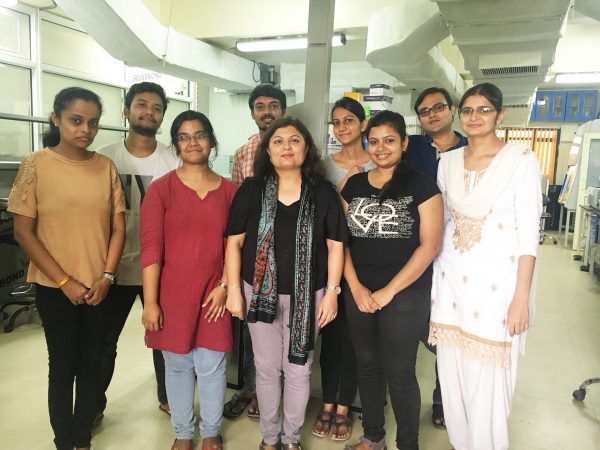Research summary
Integrating metabolism with other cellular processes provides the robustness enabling bacterial survival in diverse environments, key to their success as commensals, pathogens and industrial workhorses. Research in my laboratory is focused towards understanding the interconnections between metabolic pathways and their integration with stress responses in the model microbe, E. coli. In this direction, my lab utilizes genetic, biochemical, and systems approaches to identify and characterize novel players and networks in metabolism. Current lab projects focus on two major areas:
Systems level analysis of long chain fatty acid metabolism
Long chain fatty acids (LCFAs) are used as a rich source of metabolic energy by several bacteria including important pathogens. Since LCFAs also induce oxidative stress, which may be detrimental to the bacteria, it is imperative to understand the strategies employed by bacteria to counteract it. In this regard, by performing a high-throughput quantitative genetic screen on LCFAs and a detailed follow-up analysis of the oxidative stress response players identified from the screen, we are currently unraveling the mechanisms by which bacteria combat LCFA-induced oxidative stress. In addition, our screen has identified several uncharacterized genes and genes of known functionality but no previous linkage to LCFAs to be required for successful growth on LCFAs suggesting missing players and networks in LCFA metabolism thus opening new areas of investigation.
Understanding crosstalk of sugar acid metabolism with other metabolic pathways
E. coli utilizes a variety of sugar acids as carbon and energy source, which has been implicated in its colonization in the mammalian gut. From our genetic studies, we have identified a putative transcriptional repressor of sugar acid metabolism to be required for successful growth on fatty acids and few additional carbon sources. We are characterizing the transcriptional repressor and investigating whether there is a crosstalk between metabolic pathways of the above-mentioned carbon sources to prioritize sugar acid utilization.
Selected Publications
- Arya, G., Pal, M., Sharma, M., Singh, B., Singh, S., Agrawal, V. and Chaba, R.© (2020). Molecular insights into effector binding by DgoR, a GntR/FadR family transcriptional repressor of D-galactonate metabolism in Escherichia coli. Mol. Microbiol. doi: 10.1111/mmi.14625.
- Jaswal, K.*, Shrivastava, M.*, Roy, D., Agrawal, S. and Chaba, R.©(2020). Metabolism of long-chain fatty acids affects disulfide bond formation in Escherichia coli and activates envelope stress response pathways as a combat strategy. PLOS Genetics.16(10): e1009081.
- Singh, B., Arya, G., Kundu, N., Sangwan, A., Nongthombam, S. and Chaba, R.© (2019). Molecular and functional insights into the regulation of D-galactonate metabolism by the transcriptional regulator, DgoR, in Escherichia coli. J. Bacteriol.201(4): e00281-18.
- Khan, M. I., Mishra, A., Jha, P. K., Abhishek, K., Chaba, R., Das, P. and Sinha, K. K. (2019). DNA polymerase β of Leishmania donovani is important for infectivity and it protects the parasite against oxidative damage. Int. J. Biol. Macromol.124: 291-303.
- Agrawal, S.*, Jaswal, K.*, Shiver, A. L., Balecha, H., Patra, T. and Chaba, R.© (2017). A genome-wide screen in Escherichia coli reveals that ubiquinone is a key antioxidant for metabolism of long-chain fatty acids. J. Biol. Chem.292(49): 20086-20099.
- Lima, S., Guo, M. S., Chaba, R ., Gross, C. A. and Sauer, R. T. (2013). Dual Molecular Signals Mediate the Bacterial Response to Outer-Membrane Stress. Science 340 (6134): 837-841.
- Oh, E., Becker, A. H., Sandikci, A., Huber, D., Chaba, R ., Gloge, F., Nichols, R. J., Typas, A., Gross, C. A., Kramer, G., Weissman, J. S. and Bukau, B. (2011). Selective ribosome profiling reveals the co-translational chaperone action of trigger factor in vivo. Cell 147(6): 1295-1308. (Faculty of 1000 factor 12)
- Chaba, R .©, Alba, B.M., Guo, M., Sohn, J., Ahuja, N., Sauer, R. T. and Gross, C. A.© (2011). Signal integration by DegS and RseB governs the sigmaE mediated envelope stress response in Escherichia coli. PNAS 108(5): 2106-2111. ©co- corresponding authors (Faculty of 1000 factor 8)
- Nichols, R. J., Choo, Y. J., Sen, S., Beltrao, P., Zietek, M., Chaba, R ., Lee, S., Kazmierczak, K. M., Lee, K. J., Wong, A., Shales, M., Lovett, S., Winkler, M. E., Krogan, N. J., Typas, A. and Gross, C. A. (2011). Phenotypic Landscape of a Bacterial Cell. Cell 144(1): 143-156. (Faculty of 1000 factor 13)
- Ahuja, N., Korkin, D., Chaba, R ., Cezairliyan, B. O., Sauer, R. T., Kim, K. K. and Gross, C. A. (2009). Analyzing the interaction of RseA and RseB, the two negative regulators of the sigmaE envelope stress response, using a combined bioinformatic and experimental strategy. J. Biol. Chem. 284(8): 5403-5413.
- Thakur, M., Chaba, R ., Mondal, A. K. and Chakraborti, P. K. (2008). Interdomain interaction reconstitutes the functionality of PknA, a eukaryotic type Ser/Thr kinase from Mycobacterium tuberculosis. J. Biol. Chem. 283(12): 8023-8033.
- Chaba, R .*, Grigorova, I. L.*, Flynn, J. M., Baker, T. A. and Gross, C. A. (2007). Design principles of the proteolytic cascade governing the sigmaE mediated envelope stress response in Escherichia coli: keys to graded, buffered, and rapid signal transduction. Genes Dev. 21(1): 124-136.(This article was highlighted in the perspective in Genes and Development. Hasenbein, S., Merdanovic, M. and Ehrmann, M. (2007). Determinants of regulated proteolysis in signal transduction. Genes Dev. 21(1): 6-10.)
- Grigorova, I. L., Chaba, R ., Zhong, H. J., Alba, B. M., Rhodius, V., Herman, C. and Gross, C. A. (2004). Fine-tuning of the Escherichia coli sigmaE envelope stress response relies on multiple mechanisms to inhibit signal-independent proteolysis of the transmembrane anti-sigma factor, RseA. Genes Dev. 18(21): 2686-2697.
- Chaba, R ., Raje, M. and Chakraborti, P. K. (2002). Evidence that a eukaryotic-type serine/threonine protein kinase from Mycobacterium tuberculosis regulates morphological changes associated with cell division. Eur. J. Biochem. 269(4): 1078-1085.
- Sarin, J., Aggarwal, S., Chaba, R ., Varshney, G. C. and Chakraborti, P. K. (2001). β-subunit of phosphate-specific transporter from Mycobacterium tuberculosis is a thermostable ATPase. J. Biol. Chem. 276(48): 44590-44597.
Group
Present group members:
- Shashank Agrawal (PhD student)
- Bhupinder Singh (PhD student)
- Kanchan Jaswal (PhD student)
- Garima Arya (PhD student)
- Neeladrita Kundu (PhD student)
- Swati Singh (PhD student)
- Megha (BS-MS student)
- Sanjay (BS-MS student)


